Lockheed C-5 Galaxy Videos
|
Loading...
|
|
Lockheed C-5 Galaxy
C-5 Galaxy
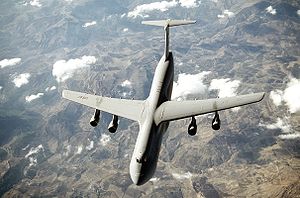
Role: Strategic airlifter
National origin: United States
Manufacturer: Lockheed
First flight: 30 June 1968
Introduction: June 1970
Status: Operational
Active: 33
Reserve: 45
ANG: 30
Primary user: United States Air Force
Produced: C-5A: 1968-1973
C-5B: 1985-1989
C-5M upgrades: 2006-present
Number built: 131 (C-5A: 81, C-5B: 50)
Unit cost: C-5B: US$167.7 million
The Lockheed C-5 Galaxy is a large military transport aircraft built by Lockheed. It was designed to provide strategic heavy airlift over intercontinental distances and to carry outsize and oversize cargo. The C-5 Galaxy has been operated by the United States Air Force (USAF) since 1969 and is one of the largest military aircraft in the world.
Development
Background
In 1961, several aircraft companies began studying heavy jet transport designs that would replace the Douglas C-133 Cargomaster transport and complement Lockheed C-141 Starlifters. In addition to higher overall performance, the United States Army wanted a transport with a larger cargo bay than the C-141, whose interior was too small to carry a variety of their outsized equipment. These studies led to the "CX-4" design concept, but in 1962 the proposed six-engine design was rejected, because it was not viewed as a significant advance over the C-141.
By late 1963, the next conceptual design was named CX-X. It was equipped with four engines, instead of six engines in the earlier CX-4 concept. The CX-X had a gross weight of 550,000 pounds (249,000 kg), a maximum payload of 180,000 lb (81,600 kg) and a speed of Mach 0.75 (500 mph/805 km/h). The cargo compartment was 17.2 ft (5.24 m) wide by 13.5 feet (4.11 m) high and 100 ft (30.5 m) long with front and rear access doors. To provide required power and range with only four engines required a new engine with dramatically improved fuel efficiency.
Heavy Logistics System
The criteria were finalized and an official Request for Proposal was sent out in April 1964 for the "Heavy Logistics System" (CX-HLS) (previously CX-X). In May 1964, proposals for aircraft were received from Boeing, Douglas, General Dynamics, Lockheed, and Martin Marietta. Proposals for engines were received from General Electric, Curtiss-Wright, and Pratt & Whitney. After a downselect, Boeing, Douglas and Lockheed were given one-year study contracts for the airframe, along with General Electric and Pratt & Whitney for the engines.
All three of the designs shared a number of features. In particular, all three placed the cockpit well above the cargo area to allow for cargo loading through a nose door. The Boeing and Douglas designs used a pod on the top of the fuselage containing the cockpit, while the Lockheed design extended the cockpit profile down the length of the fuselage, giving it an egg-shaped cross section. All of the designs featured swept wings and front and rear cargo doors allowing simultaneous loading and unloading. Lockheed's design featured a T-tail, while the designs by Boeing and Douglas had conventional tails.
The Air Force considered Boeing's design better than the Lockheed design, although Lockheed's proposal was the lowest total cost bid. Lockheed was selected the winner in September 1965, then awarded a contract in December 1965. General Electric's engine design was selected in August 1965 for the new transport.
Into production
The first C-5A Galaxy (number 66-8303) was rolled out of the manufacturing plant in Marietta, Georgia on 2 March 1968. On 20 June 1968, Lockheed-Georgia Co. began flight testing its new Galaxy C-5A heavy transport with the aircraft's first flight taking to the air under the call-sign "eight-three-oh-three heavy" (8303H). Cost overruns and technical problems of the C-5A were the subject of a congressional investigation in 1968 and 1969. The Lockheed C-5 program holds the dubious distinction of being the first program to produce a one billion dollar overrun.
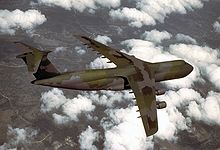
Picture - The fourth C-5A Galaxy 66-8306 in 1980s European One color scheme
Upon completion of testing the first C-5A was transferred to the Transitional Training Unit at Altus Air Force Base, OK, in December 1969. Lockheed then delivered the first operational Galaxy to the 437th Airlift Wing, Charleston Air Force Base, SC, in June 1970. Due to the higher than expected development costs, there were calls within the military as early as in June 1970 for the government to split the losses that Lockheed were experiencing. Production was nearly brought to a halt in 1971 due to Lockheed going through financial difficulties, brought on in part due to the C-5 Galaxy but also by the civilian jet liner, the Lockheed L-1011. The U.S. government loaned Lockheed money so they could keep running.
In the early 1970s, NASA considered the C-5 for the Shuttle Carrier Aircraft role, to transport the Space Shuttle to Kennedy Space Center. However, they rejected it in favor of the Boeing 747, in part due to the 747's low-wing design. In contrast, the Soviet Union chose to transport its shuttles using the high-winged An-225, which derives from the An-124, which is similar in design and function to the C-5.
During static and fatigue testing, cracks in the wings of several aircraft occurred before completion of testing. All of the C-5A fleet were restricted to 80% of maximum design loads. To reduce wing loading, load alleviation systems were added to the aircraft. By 1980, payloads were restricted to as low as 50,000 lb (23,000 kg) for general cargo during peacetime operations. To restore full payload capability and service life, a $1.5 billion program to re-wing the 76 C-5As began in 1976. After design and testing of the new wing design, the C-5As received their new wings from 1980 to 1987. During 1976, numerous cracks were also found in the fuselage along the upper fuselage on centerline aft of the refueling port and extending back to the wing. The cracks required a redesign to the hydraulic system for the visor, the front cargo entry point.

Picture - C-5 Galaxy USAF video
In 1974, Iran, then ruled by a monarchy which maintained good relations with the United States, offered $160 million to restart the production of the C-5 to enable them to make their own procurements of the Galaxy; in a similar climate as to their acquisition of F-14 Tomcat fighters. However no C-5 aircraft were ever ordered by Iran, as the prospect was firmly halted by the Iranian Revolution in 1979.
As part of President Ronald Reagan's military planning, a new version of the C-5, the C-5B, was approved by Congress for purchase in July 1982. The first C-5B was delivered to Altus Air Force Base in January 1986. In April 1989, the last of 50 C-5B aircraft was added to the 77 C-5As in the Air Force's airlift force structure. The C-5B includes all C-5A improvements and numerous additional system modifications to improve reliability and maintainability.
In 1998, the Avionics Modernization Program (AMP) began upgrading the C-5's avionics to include a glass cockpit, navigation equipment, and a new autopilot system. Another part of the C-5 modernization effort is the Reliability Enhancement and Re-engining Program (RERP). The program will mainly replace the engines with newer, more powerful ones. Three C-5s are to undergo RERP as a test with full production planned to begin in May 2008.
Design
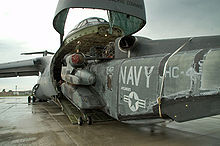
Picture - The forward section of the C-5 Galaxy lifts open to allow loading of bulky items, such as this MH-53 helicopter.
The C-5 is a large high-wing cargo aircraft. It has a distinctive high T-tail, 25 degree wing sweep, and four TF39 turbofan engines mounted on pylons beneath the wings. The C-5 is similar in layout to its smaller predecessor, the C-141 Starlifter. The C-5 has 12 internal wing tanks and is equipped for aerial refueling. It has both nose and aft doors for "drive-through" loading and unloading of cargo.
The C-5 features a cargo compartment 121 ft (37 m) long, 13.5 ft (4.1 m) high, and 19 ft (5.8 m) wide, or just over 31,000 cu ft (880 m). The compartment can accommodate up to 36 463L master pallets or a mix of palletized cargo and vehicles. The cargo hold of the C-5 is actually a foot longer than the length of the first powered flight by the Wright Brothers' Flyer at Kitty Hawk. The nose and aft doors open the full width and height of the cargo compartment to permit faster and easier loading. Ramps are full width at each end for loading double rows of vehicles.
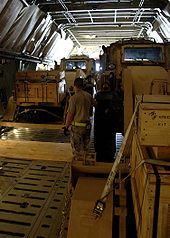
Picture - Excavators in the rear of a C-5. Loadmasters must ensure cargo is secured and weight distribution is balanced before takeoff.
It has an upper deck seating area for 73 passengers. The passengers face the rear of the aircraft, rather than forward. Its takeoff and landing distances, at maximum gross weight, are 8,300 ft (2,500 m) and 4,900 ft (1,500 m) respectively. Its high flotation main landing gear has 28 wheels to share the weight. The rear main landing gear is steerable for a smaller turning radius and it rotates 90 degrees horizontally before it is retracted after takeoff. The "kneeling" landing gear system permits lowering of the parked aircraft so the cargo floor is at truck-bed height to facilitate vehicle loading and unloading.
The C-5 has a Malfunction Detection Analysis and Recording (MADAR) system, which records and analyzes information and detects malfunctions in more than 800 test points. The C-5 is also known as FRED (fucking ridiculous economic/environmental disaster) by its crews due to its maintenance/reliability issues and large consumption of fuel. The C-5 requires an average of 16 hours of maintenance for each flight hour based on 1996 data. The Galaxy has a Low Pressure Pneumatic System (LPPS) that utilizes a turbo compressor driven by bleed air to provide 150 psi pressure for inflating aircraft's tires on the ground.
The Galaxy is capable of carrying nearly every type of the Army's combat equipment, including bulky items such as the 74 short tons (67 t) armored vehicle launched bridge (AVLB), from the United States to any location on the globe.
Operational history
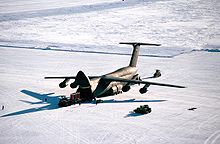
Picture - Personnel unload cargo from a C-5 Galaxy on an ice runway near McMurdo Station, Antarctica in 1989.
The first C-5A was delivered to the USAF on 17 December 1969. Wings were built up in the early 1970s at Altus AFB, Oklahoma, Charleston AFB, Dover AFB, Delaware, and Travis AFB, California. 9 July 1970 marked the C-5's first mission in Southeast Asia during the Vietnam War. Through the rest of the war, C-5s were used to transport equipment and troops; included Army tanks and various smaller aircraft. C-5s have also been used to deliver support and reinforce various U.S. allies over the years, critically delivered weapons and supplies to Israel as part of Operation Nickel Grass in 1973, in which the aircraft performed to such a high degree that the Pentagon considered further purchases. The C-5 was also made available to support British-led peacekeeping efforts in Zimbabwe in 1979.
The C-5 is the largest aircraft to ever operate in the Antarctic. Williams Field near McMurdo Station is capable of handling C-5 aircraft and the first C-5 landed there in 1989. The C-5 Galaxy was a core part of the extensive airlift operations supplying troops involved in the First Gulf War, and in delivering relief aid to Rwanda in 1994.
The wings on the C-5As were replaced during the 1980s to restore full design capability. The U.S. Air Force took delivery of the first C-5B on 28 December 1985 and the final one in April 1989. The reliability of the C-5 fleet has been a continued issue throughout its lifetime, however the C-5M upgrade program seeks in part to address this issue.
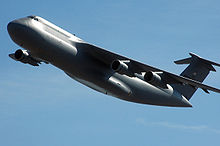
Picture - A C-5 from Robins AFB
In response to Air Force motions towards the retirement of the C-5 Galaxy, Congress implemented legislation that placed set limits upon retirement plans for C-5A models in 2003. By 2005, 14 C-5As were retired. One was sent to the Warner Robins Air Logistics Center (WR-ALC) for tear down and inspection to evaluate structural integrity and estimate the remaining life for the fleet. Thirteen C-5As were sent to the Air Force's Aerospace Maintenance and Regeneration Group (AMARG) for inspection of levels of corrosion and fatigue.
In 2007 the Air Force requested information on the Airbus A380 freighter for possible use as a military transport to supplement the U.S. strategic airlift fleet.
The U.S. Air Force began to receive refitted C-5M aircraft in December 2008; full production of C-5Ms began in the summer of 2009. In 2009, the Congressional ban on the retirement of C-5s was overturned. The Air Force seeks to retire one C-5A for each 10 new C-17s ordered.
Variants
C-5A
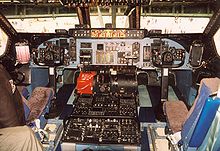
Picture - Instrument panel of a C-5A
The C-5A is the original version of the C-5. From 1969 to 1973, 81 C-5As were delivered to U.S. Air Forces bases. Due to cracks found in the wings in the mid-1970s, the cargo weight was restricted. To restore the plane's full capability, the wing structure was redesigned. A program to install new strengthened wings on 77 C-5As was conducted from 1981 to 1987. The redesigned wing made use of a new aluminum alloy that did not exist during the original production.
C-5B
The C-5B is an improved version of the C-5A. It incorporated all modifications and improvements made to the C-5A with improved wings, upgraded TF-39-GE-1C turbofan engines and updated avionics. From 1986 to 1989, 50 of the new variant were delivered to the U.S. Air Force.
C-5C
The C-5C is a specially modified variant for transporting large cargo. Two C-5s (68-0213 and 68-0216) were modified to have a larger internal cargo capacity to accommodate large payloads, such as satellites for use by NASA. The major modifications were the removal of the rear passenger compartment floor, splitting the rear cargo door in the middle, and installing a new movable aft bulkhead further to the rear. Modifications also included adding a second inlet for ground power, which can feed any power-dependent equipment that may form part of the cargo. The two C-5Cs are operated by U.S. Air Force crews on the behalf of NASA, and are stationed at Travis AFB, California. 68-0216 completed the Avionics Modernization Program in January 2007.
C-5M
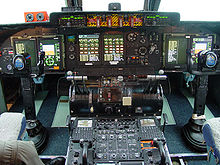
Picture - New instrument panel for C-5 as part of AMP program
Based on a recent study showing 80% of the C-5 airframe service life remaining, AMC began an aggressive program to modernize all remaining C-5Bs and C-5Cs and many of the C-5As. The C-5 Avionics Modernization Program (AMP) began in 1998 and includes upgrading avionics to Global Air Traffic Management compliance, improving communications, new flat panel displays, improving navigation and safety equipment, and installing a new autopilot system. The first flight of the first modified C-5 with AMP (85-0004) occurred on 21 December 2002.
Another part of the plan is a comprehensive Reliability Enhancement and Re-engining Program (RERP), which includes new General Electric CF6-80C2 engines, pylons and auxiliary power units, with upgrades to aircraft skin and frame, landing gear, cockpit and the pressurization system. The CF6 engine produces 22% more thrust (for 50,000 lbf/220 kN total from each engine) than existing C-5 engines, which will result in a 30% shorter takeoff roll, a 38% higher climb rate to initial altitude, a significantly increased cargo load, and a longer range between refueling. The C-5s that complete these upgrades are designated C-5M Super Galaxy.
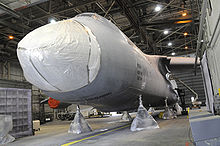
Picture - A Galaxy undergoing the AMP and RERP upgrades, to make it a C-5M.
The C-5 AMP and RERP modernization programs plan to raise mission-capable rate to a minimum goal of 75%. Over the next 40 years, the U.S. Air Force estimates the C-5M will save over $20 billion. The first C-5M conversion was completed on 16 May 2006, and performed its first flight on 19 June 2006. C-5Ms have been in flight testing out of Dobbins Air Reserve Base since June 2006. Test aircraft include a distinctively colored nose boom to acquire flight data.
The USAF decided to convert remaining C-5Bs and C-5Cs into C-5Ms with avionics upgrades and re-engining in February 2008. The C-5As will receive only the avionics upgrades. The three test C-5Ms successfully completed developmental flight testing in August 2008. The test aircraft will begin Operational Test and Evaluation in September 2009. The RERP upgrade program is to be completed in 2016.
Lockheed Martin announced that a C-5M test flight on 13 September 2009, set 41 new records. The flight's data have been submitted to the National Aeronautic Association for formal acceptance. The C-5M carried a payload of 176,610 lb (80,110 kg) to over 41,100 ft (12,500 m) in 23 minutes, 59 seconds. The flight set 33 time to climb records at various payload classes, and broke the world record for greatest payload to 6,562 feet (2,000 meters). The aircraft used for this flight had a takeoff weight of 649,680 lb (294,690 kg), which included payload, fuel and crew.
Operators
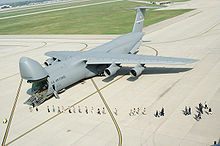
Picture - People in line to enter the 445th Airlift Wing's first C-5A Galaxy in 2005.
Unlike its Soviet (Ukrainian) counterpart, the civilian- and military-operated Antonov An-124 Ruslan or An-225 Mriya, use of the C-5 is confined entirely to the military and government.
60th Air Mobility Wing, Travis Air Force Base, California
22d Airlift Squadron
97th Air Mobility Wing, Altus Air Force Base, Oklahoma
56th Airlift Squadron
105th Airlift Wing, (ANG), Stewart ANGB, New York
137th Airlift Squadron
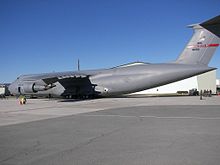
Picture - A C-5 Galaxy of the West Virginia Air National Guard 167th Airlift Wing
164th Airlift Wing, (ANG), Memphis International Airport, Tennessee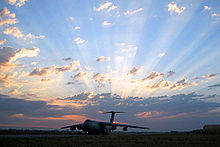
Picture - A C-5 Galaxy from the Air Force Reserve Command's 433rd Airlift Wing
356th Airlift SquadronIncidents and accidents
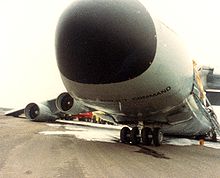
Picture - C-5A after crash landing at Shemya AFB, AK, July 1983
There have been five C-5 Galaxy aircraft lost in crashes along with two class-A losses resulting from ground fire and one loss resulting from damage sustained on the ground. There have been at least two other C-5 crashes that resulted in major airframe damage, but the aircraft were repaired and returned to service.
Notable accidents
On 27 May 1970, C-5A serial number 67-0172 was destroyed during a ground fire at Palmdale, California after an Air Turbine Motor (ATM) started backwards and quickly overheated, setting the hydraulic system on fire and quickly consuming the aircraft. The engines were not running at the time of the fire. Five crew escaped, but seven firefighters suffered minor injuries fighting the blaze.
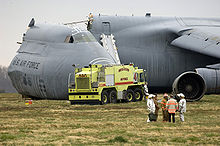
Picture - Emergency responders at the scene of a C-5B crash at Dover AFB, Del., April 2006
On 17 October 1970, C-5A S/N 66-8303 was destroyed during a ground fire at Marietta, Georgia. The fire started during maintenance in one of the aircraft's 12 fuel cells. One worker was killed and another injured. This was the first C-5 aircraft produced.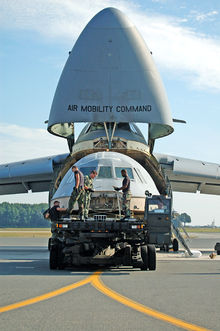
Picture - The flight deck from the C-5B crash at Dover AFB in April 2006 being loaded into another C-5
On 31 July 1983, C-5A 70-0446 crashed on landing at Shemya, Alaska. The C-5 approached below the glide slope, hit an embankment short of the runway and bounced back into the air before coming to rest on the runway. Structural damage was extensive. The airplane keel and two structural mainframes were broken, and the two aft main landing gear bogies were sheared from the airplane. There were no fatalities. A joint USAF/Lockheed team made repairs enabling a one-time ferry flight from Shemya to the Lockheed plant in Marietta, Georgia. There, the airplane was quickly christened Phoenix II and permanent repair efforts got underway. In addition to the structural repairs, Phoenix II also received an improved landing gear system (common to the then-new C-5B), wing modification, and a color weather radar upgrade. The airplane was returned to service, and was transferred to the Texas Air National Guard.Specifications (C-5B)
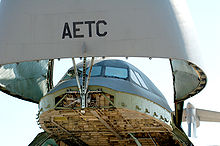
Picture - A detail of the C-5's nose assembly raised for loading and unloading.
Data from USAF fact sheet, Lockheed-Martin C-5, International Directory of Military Aircraft, and Quest for Performance.
General characteristics
Crew: 8 typical (pilot, first pilot, copilot, two flight engineers, three loadmasters)
4 minimum (pilot, copilot, two flight engineers)
Payload: 270,000 lb (122,470 kg)
Length: 247 ft 1 in (75.31 m)
Wingspan: 222 ft 9 in (67.89 m)
Height: 65 ft 1 in (19.84 m)
Wing area: 6,200 ft (576 m)
Empty weight: 380,000 lb (172,370 kg)
Loaded weight: 769,000 lb (348,800 kg)
Max takeoff weight: 840,000 lb (381,000 kg)
Powerplant: 4x— General Electric TF39-GE-1C high-bypass turbofan, 43,000 lbf (190 kN) each
Performance
Maximum speed: Mach 0.79 (503 kn, 579 mph, 932 km/h)
Cruise speed: Mach 0.77 (919 km/h)
Range: 2,400 nmi (2,760 mi, 4,440 km) with a 263,200 lb payload
Service ceiling: 35,700 ft (10,600 m) at 615,000 lb (279,000 kg) gross weight
Rate of climb: 1,800 ft/min (9.14 m/s)
Wing loading: 120 lb/ft (610 kg/m)
Thrust/weight: 0.22
Takeoff roll: 8,400 ft (2,600 m)
Landing roll: 3,600 ft (1,100 m)
Fuel capacity: 51,150 US gal (193,600 L)
Comparable aircraft
Airbus A380
Antonov An-124
Antonov An-225
Boeing 747
C-17 Globemaster III
Bibliography
"The Giants of Georgia". Air International, February 1984, Vol. 26, No. 2, pp. 61-68, 87-90. ISSN 0306-5634.
Irving, Clive. Wide Body: The Triumph of the 747. New York: W. Morrow, 1993. ISBN 0-688-09902-5.
Lippincott, Richard. C-5 Galaxy in Action. Carrolton, Texas: Squadron/Signal Publications, 2006. ISBN 0-89747-504-6.
Norton, Bill. Lockheed Martin C-5 Galaxy. North Branch, Minnesota: Specialty Press, 2003. ISBN 1-58007-061-2.
Reed, Chris. Lockheed C-5 Galaxy. Atglen, Pennsylvania: Schiffer Publishing, 2000. ISBN 0-7643-1205-7.
Lockheed C-5 Galaxy Pictures and Lockheed C-5 Galaxy for Sale.
Living Warbirds: The best warbirds DVD series.
Source: WikiPedia